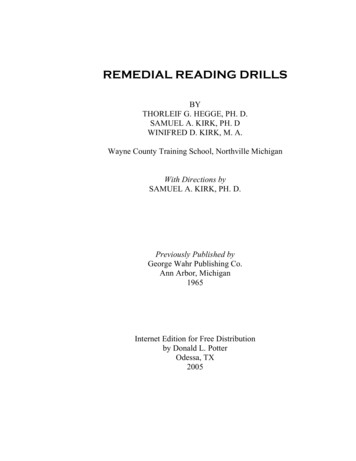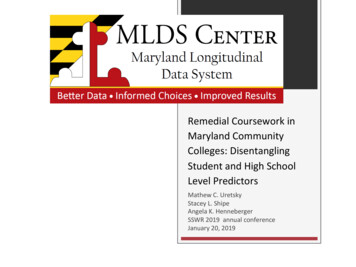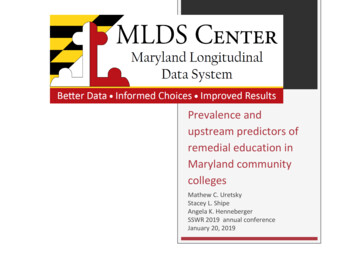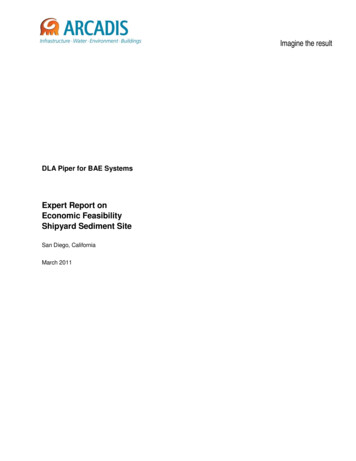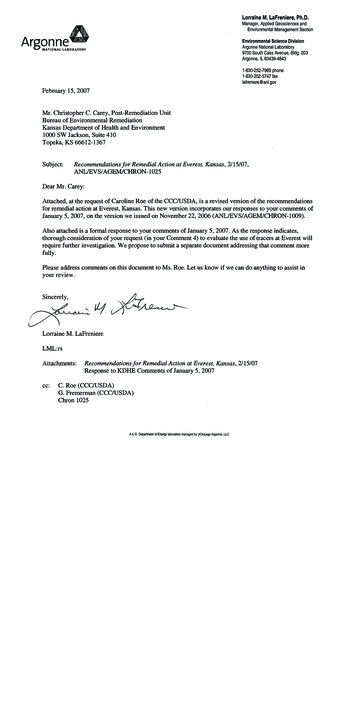
Transcription
Recommendations for Remedial Action at Everest, Kansas, 2/15/071Recommendations for Remedial Action at Everest, KansasIntroductionOn September 7, 2005, the Commodity Credit Corporation of the U.S. Department ofAgriculture (CCC/USDA) presented a Scoping Memo (Argonne 2005) for preliminaryconsideration by the Kansas Department of Health and Environment (KDHE). This documentsuggested possible remedial options for the carbon tetrachloride contamination in groundwater atEverest, Kansas. The suggested approaches were discussed by representatives of the KDHE, theCCC/USDA, and Argonne at the KDHE office in Topeka on September 8-9, 2005, along withother technical and logistic issues related to the Everest site. In response to these discussions, theKDHE recommended (KDHE 2005) evaluation of several remedial processes, either alone or incombination, as part of a Corrective Action Study (CAS) for Everest. The primary remedialprocesses suggested by the KDHE included the following: Hydraulic control by groundwater extraction with aboveground treatment Air sparging–soil vapor extraction (SVE) in large-diameter boreholes PhytoremediationAs a further outcome of the 2005 meeting and as a precursor to the proposed CAS, theCCC/USDA completed the following supplemental investigations at Everest to address severalspecific technical concerns discussed with the KDHE: Construction of interpretive cross sections at strategic locations selected bythe KDHE along the main plume migration pathway, to depict thehydrogeologic characteristics affecting groundwater flow and contaminantmovement (Argonne 2006a). A field investigation in early 2006 (Argonne 2006c), as follows:-Installation and testing of a production well and associated observationpoints, at locations approved by the KDHE, to determine the response ofthe Everest aquifer to groundwater extraction near the Nigh property.-Groundwater sampling for the analysis of volatile organic compounds(VOCs) and the installation of additional permanent monitoring points atlocations selected by the KDHE, to further constrain the existingcontaminant plume.-Resampling of all existing permanent monitoring points for VOCs andbiodegradation parameter analyses, at the request of the KDHE.On the basis of these studies (Argonne 2006a,c) and the CCC/USDA’s past investigationsat Everest (Argonne 2006b), the CCC/USDA concluded that groundwater extraction is not aneffective remedial option for this site, and the KDHE concurred (KDHE 2006). As outlined inthe next section, the CCC/USDA also believes that air sparging does not represent a viableremedial alternative. The CCC/USDA therefore proposes to collect the technical data required toevaluate the potential viability of a phytoremediation approach for this site and, if appropriate, tosupport the development of a remedial design.
Recommendations for Remedial Action at Everest, Kansas, 2/15/072Preliminary Assessment of the Groundwater Extraction and Air Sparging AlternativesThe CCC/USDA’s investigations at Everest have demonstrated highly heterogeneoushydraulic conductivity values that can vary significantly over relatively short vertical and lateraldistances. This is true throughout much of the aquifer unit along the observed contaminantmigration pathway, and particularly near Prairie Road and the Nigh property. The CCC/USDAhas attempted to extract groundwater from the aquifer unit at multiple locations (wells MW1,MW2, PT1, and the Nigh private well [DW06]; Figure 1) along the contaminant migrationpathway. The results demonstrated sustainable flow rates to wells of approximately 1 gpm orless, generally with an effective radius of influence for each well of 100 ft or less.Many of the demonstrated hydrogeologic and logistic concerns (outlined above) that limitthe effectiveness of groundwater extraction would also apply to air sparging–SVE. Theimplementation of this alternative to address the carbon tetrachloride contamination along muchof the plume migration pathway would require the drilling of multiple, closely spaced boreholesto depths of 50-60 ft or more. Because the contamination of concern is restricted to the saturatedzone, no remedial benefit would be achieved by removing relatively large volumes ofuncontaminated vadose zone soils in the upper portion of each boring. The heterogeneity of theEverest aquifer unit would restrict the vertical and lateral influence of sparging in the saturatedzone beyond each borehole, in a way that is difficult to predict. Consequently, applying thistechnique as a containment measure along Prairie Road would have little influence oncontaminant migration rates and pathways throughout most of the aquifer unit.Representatives of the city and the county have expressed reservations regarding the needfor further characterization or remediation activities at Everest, as have local private landowners.The CCC/USDA’s experience indicates that the potential installation of groundwater extractionwells, air sparging wells, or other remedial facilities in the identified contaminant migrationpathway northwest of the former CCC/USDA facility would be highly disruptive to currentagricultural land use and might be met with strong resistance by the affected property ownersand the local community.The CCC/USDA therefore concludes that neither groundwater extraction nor airsparging coupled with SVE in large-diameter boreholes represents a practical approach foreffective remediation of the groundwater contamination at Everest.Preliminary Assessment of Risks to Human Health and the EnvironmentUnder the present water and land use conditions at Everest, the identified carbontetrachloride contamination in groundwater poses no unacceptable health threat to the residentsof the city or to occupants of any private residences identified in the vicinity of the town that arenot connected to the municipal water supply (Argonne 2006b). No carbon tetrachloride has beendetected in the vadose zone soils at the former CCC/USDA facility at levels that would requireremediation of the soils under the Tier 2 risk-based standards for carbon tetrachloride presentedin the KDHE Risk Based Standards for Kansas (RSK Manual; KDHE 2003).Argonne’s investigations (Argonne 2006b) indicate that the migration pathway of thecontaminated groundwater will turn southwestward in the vicinity of the intermittent creek westof the Nigh property, toward an area of groundwater seepage identified along the lower reach ofthe creek (Figure 2). The identified patterns of groundwater flow and contaminant migration
Recommendations for Remedial Action at Everest, Kansas, 2/15/073therefore indicate that the carbon tetrachloride plume could represent a future human health orenvironmental risk, as a result of contaminant discharge to the surface waters of the creek in thegroundwater seepage area.The results of periodic groundwater sampling and analyses by the CCC/USDAdemonstrate that the areal extent and range of carbon tetrachloride concentrations detected in theplume at Everest have changed relatively little during the investigations at this site (2000 topresent). No carbon tetrachloride has been detected in the waters of the creek. The results (as ofFebruary 2006) suggest that the dilute (carbon tetrachloride concentrations 1 μg/L)downgradient toe of the groundwater plume lies approximately 500 ft east of the intermittentcreek bed directly west of the Nigh property and approximately 3,500 ft northeast of the area ofgroundwater seepage to the surface identified farther downstream along the creek (Figure 2).The potential carbon tetrachloride concentrations in the creek waters that might resultfrom future contaminant discharge are unknown and cannot be reasonably predicted.Approximations can be made, however, of the migration times required for the plume to reach(1) the immediate area along the intermittent creek directly west of the Nigh property, whichrepresents the upgradient limit along the projected migration pathway at which the contaminatedgroundwater might be shallow enough to effectively implement a phytoremediation treatmenttechnology (see discussion to follow), and (2) the downstream groundwater seepage area. Simpleestimates of these times made by applying Darcy’s law, hydraulic property data for the aquiferunit west of the Nigh property (Argonne 2006b), and the range of hydraulic gradients for thisarea determined from ongoing water level monitoring (Argonne 2003, 2006b,c) are inAttachment 1. The estimates demonstrate the range of uncertainties resulting from theheterogeneity of the hydraulic conductivity distribution and the interpreted complexity of themigration pathways at Everest. Nevertheless, the results in Attachment 1 suggest that, atminimum, approximately 4 yr will be required for the carbon tetrachloride plume (in thesubsurface) to reach the vicinity of the creek directly to the west, while more than 20 yr will berequired to reach the identified groundwater discharge area to the southwest.The CCC/USDA therefore concludes that the existing plume poses no immediate dangerof contamination to the surface waters of the creek.Recommendation of the Phytoremediation AlternativeIn light of the above observations, the CCC/USDA proposes phytoremediation as apotentially viable alternative for protection of the surface waters of the creek and restoration ofthe Everest groundwater. The CCC/USDA recently implemented a full-scale phytoremediationprogram under the regulatory supervision of Region VII of the U.S. Environmental ProtectionAgency (EPA), to address groundwater contamination in Murdock, Nebraska, in a hydrologicsetting roughly analogous to that at Everest. At Murdock, selected plant species (more than 2,000trees, plus associated groundcover and buffer zone vegetation) are being used in conjunctionwith constructed wetlands to reduce initial carbon tetrachloride concentrations in excess of300 μg/L in shallow groundwater approaching an area of surface discharge to a small creek.Initial (first-year) sampling and monitoring data for the Murdock site indicate that this remedialapproach has already achieved non-detectable levels of carbon tetrachloride in the creek watersimmediately downstream of the coupled phytoremediation and wetlands treatment zones(Argonne 2006d).
Recommendations for Remedial Action at Everest, Kansas, 2/15/074By employing phytoremediation and wetland technologies, the CCC/USDA was able toestablish a largely self-sustaining remedial system at Murdock that is expected to functioneffectively for the projected lifetime (approximately 40 yr) of the groundwater cleanup. TheCCC/USDA and the EPA obtained ready community acceptance of this approach, because theconstructed treatment areas both enhance wildlife habitat and increase recreational opportunitiesfor the local residents, with minimal disruption to the surrounding agricultural lands.Figure 3 presents an estimate of the area where phytoremediation would be technicallyfeasible at Everest, as the projected groundwater plume approaches the creek during the next4 yr or more. As the figure shows, the potentially viable area for phytoremediation is along thecreek trend west and downgradient of the Nigh property. Planting there would have minimaleffect on agricultural use of the surrounding private lands. This estimate of the area feasible forphytoremediation was generated on the basis of recorded groundwater levels in the areacharacterized by the CCC/USDA, under the assumption that the limiting depth for ready use ofphytoremediation (with special planting techniques to promote deep root penetration by treeswhere necessary) is approximately 15 ft below ground level (BGL). As the carbon tetrachlorideplume progressively migrates southwestward and downgradient toward the natural groundwaterdischarge area, the area with shallower groundwater (suitable for conventional plantings, withoutthe special deep-rooting techniques) will expand, therefore increasing the potential effectivenessof phytoremediation.Proposal for Further Investigation of the Phytoremediation AlternativeThe CCC/USDA believes that the phytoremediation approach outlined above represents apotentially viable and practical alternative for addressing the carbon tetrachloride contaminationat Everest, in a way that will be protective of human health and the environment and acceptableto the local community. The CCC/USDA also believes, however, that the expected time framerequired for the contaminant plume to reach the optimal treatment area offers an opportunity tocollect additional data required to fully evaluate this remedial alternative. Therefore, theCCC/USDA seeks KDHE approval for a program of systematic groundwater sampling andmonitoring at Everest. This monitoring will be a precursor to the submission of a detailedassessment of remedial alternatives, including phytoremediation, for the Everest site in thecontext of a CAS or other regulatory framework preferred by the KDHE.Objectives. The specific technical objectives of the proposed monitoring activities are asfollows: To verify the CCC/USDA’s present interpretation that continued groundwaterflow and contaminant migration will generally follow the trend of theintermittent creek west and southwest of the Nigh property, ultimatelyapproaching the downstream seepage area along the creek. To document the contaminant migration rates and the evolution of carbontetrachloride concentrations as the plume approaches the intermittent creek,and hence to determine the requirements and the optimal time frame forimplementation of phytoremediation or other remedial alternatives to protectthe quality of the creek surface waters.
Recommendations for Remedial Action at Everest, Kansas, 2/15/07 To gather additional data regarding the patterns of seasonal and longer-termgroundwater and surface water level variations along the lower reaches of theintermittent creek and thus to define more precisely the areas amenable topotential phytoremediation planting. To generate information on the hydrologic balance among local precipitation,evapotranspiration, recharge to the aquifer, and the contributions of surfacerunoff and groundwater flow to the intermittent creek, which will affect thedesign parameters of the proposed phytoremediation treatment zone.Monitoring Activities. To address these proposed objectives, the CCC/USDA proposesa phased program of groundwater and surface water monitoring activities. The CCC/USDArecommends that the Phase I activities be conducted at Everest for a minimum period of twoyears. The activities to be performed during Phase I of the program are the following: Annual sampling of groundwater for determination of VOCs and selectedindicator parameters of possible natural biodegradation processes (dissolvedoxygen, FeII, oxidation-reduction potential) at the existing permanentmonitoring points shown in Figure 4. If evidence of significant naturalbiodegradation is found, additional indicator parameters will be selected foranalysis in accord with the KDHE policy for monitoring of natural attenuation(KDHE 2001). Twice yearly sampling (during the first year of Phase I) and quarterlysampling (thereafter during Phase I) of groundwater for VOCs and indicatorparameter analyses at the existing suite of permanent monitoring points alongthe presently identified lateral margins of the carbon tetrachloride plume(MW3, SB49, SB62, SB63, SB64, SB72, SB78, SB79S, SB79D, SB80), plusMW4 and SB60 near the Nigh property (Figure 5), to document thedowngradient migration of the contamination over time. During each year,one of these sampling events will coincide with the annual sampling discussedabove; the other(s) will be performed separately. Twice yearly sampling (during the first year of Phase I) and quarterlysampling (thereafter during Phase I) of surface water at five permanentlocations to be established in the groundwater seepage area and along theupstream portion of the intermittent creek (Figure 6). The samples will beanalyzed for VOCs to document that carbon tetrachloride at unacceptablelevels has not reached the surface waters of the creek during the monitoringperiod. During each year, one of these sampling events will coincide with theannual sampling discussed above; the other(s) will be performed separately. Maintenance of the existing network of automated groundwater levelmonitoring points (Figure 7).At any time during Phase I of the proposed monitoring program, if the KDHE andthe CCC/USDA conclude (on the basis of the sampling results) that a more acceleratedtime frame is required for remedy selection at Everest, the CCC/USDA will proceed toPhase II of the program. In Phase II, the following additional monitoring activities will be5
Recommendations for Remedial Action at Everest, Kansas, 2/15/076conducted (in conjunction with the annual and quarterly sampling events outlined above)for a minimum further period of one year: Continuous water level monitoring with automated logging equipment atpermanent observation points to be established along the more downstreamand perennial portions of the creek, to determine seasonal variations in surfacewater and groundwater levels. Establishment of a permanent recording weather station in the immediatevicinity of the potential phytoremediation area. This station will generateclimate data for use in evaluation of the hydrologic balance at the prospectivetreatment site. Parameters to be monitored should include air temperature,relative humidity, precipitation, wind speeds and direction, solar andultraviolet radiation levels, and local soil moisture. A one-time survey of the natural vegetation types and density along the creektrend in the vicinity of the potential phytoremediation area. Twice yearly sampling of natural plants at selected locations along the creektrend (locations to be determined on the basis of the survey results). Thesamples will be analyzed for VOCs to identify possible contaminant uptakeand estimate the potential phytoremediation capability of the existingvegetation.The proposed supplemental activities in Phase II will provide critical data required forsubsequent remedial design evaluation of phytoremediation in the context of a CAS or under theregulatory framework the KDHE prefers.The above activities are summarized in Table 1.At the request of the KDHE, the CCC/USDA and Argonne will investigate the possibleuse of tracers to monitor the migration and fate of the carbon tetrachloride contamination ingroundwater as it approaches the area(s) targeted for possible phytoremediation. In particular, theviability of using inorganic, isotopic, or other geochemical species to track groundwater uptakeby the natural vegetation (as well as by possible phytoremediation plantings) near theintermittent creek will be evaluated. If indicator species and analysis methods suitable for use inthis manner can be identified, the CCC/USDA will present recommendations to the KDHE forpossible tracer use as part of the present monitoring program or in conjunction with aphytoremediation remedy.Reporting. Data from each of the proposed monitoring events will be submitted to theKDHE for review within 60 days of the completion of field activities. The reporting activitieswill be as follows: Twice yearly reporting during the first year of Phase I — and quarterlyreporting thereafter — of analytical results for each sampling event to theKDHE as a brief data report. Annual summary reporting, with interpretation, of the results of all samplingand monitoring activities during the preceding calendar year. These annual
Recommendations for Remedial Action at Everest, Kansas, 2/15/077performance reports will be submitted for KDHE review and approvalthroughout the monitoring program.Consultation between the KDHE and CCC/USDA project managers is recommended aseach new report is released, to determine the merits of continuing the current phase of themonitoring program or to discuss modifications that may be required to address additional dataneeds.TABLE 1 Summary of sampling and monitoring requirements proposed for Everest, for a minimum totalperiod of approximately 3 yr (Phase I and Phase II).Sampling or Monitoring ActivityLocationsFrequencyGroundwater sampling frompermanent monitoring points,for VOCs analyses andselected biodegradationindicatorsFigure 4AnnuallyGroundwater sampling at wellson the plume margins, plusMW4 and SB60Figure 5Twice annually (once incoincidence with theannual event, plus oneadditional event)Four times annually (oncein coincidence with theannual event, plusthree additional events)Phase(s)I and III (1st year)I (2nd year)and III (1st year)I (2nd year)and IISurface water sampling in thegroundwater seepage andupstream creek areas, forVOCs analyses onlyFigure 6Twice annuallyFour times annuallyGroundwater level monitoring atexisting permanent monitoringpointsFigure 7Continuously (water levelrecorders)I and IIGroundwater and surface waterlevel monitoring in newlocationsLocations to bedetermined in thedownstream andperennial parts of thecreekContinuously (water levelrecorders)IIEstablishment of weather stationIn proposedphytoremediation areaContinuously (automateddata logging)IISurvey of natural vegetationtypes and densityAlong creek trendOne timeIISampling of natural plants forVOCs analysesLocations to be selectedalong creek trendTwice annuallyII
Recommendations for Remedial Action at Everest, Kansas, 2/15/078ReferencesArgonne, 2003, Final Phase II Report: QuickSite Investigation, Everest, Kansas, ANL/ER/TR03/003, prepared for the Commodity Credit Corporation. U.S. Department of Agriculture, byArgonne National Laboratory, Argonne, Illinois, September.Argonne, 2005, Scoping Memo for the Discussion of Potential Remedial Options for theGroundwater Contamination Site at Everest, Kansas, ANL/ER/AGEM/CHRON-883, preparedfor the Commodity Credit Corporation. U.S. Department of Agriculture, by Argonne NationalLaboratory, Argonne, Illinois, September 6.Argonne, 2006a, 2005 Cross Section Analysis and Recommendations for Further Studies atEverest, Kansas, ANL/EVS/AGEM/TR-05-02, prepared for the Commodity Credit Corporation.U.S. Department of Agriculture, by Argonne National Laboratory, Argonne, Illinois, January.Argonne, 2006b, Final Report: Phase III Targeted Investigation, Everest, Kansas, ANL/ER/TR04/004, prepared for the Commodity Credit Corporation. U.S. Department of Agriculture, byArgonne National Laboratory, Argonne, Illinois, January.Argonne, 2006c, Final Report: Results of Aquifer Pumping and Groundwater Sampling atEverest, Kansas, in January-March 2006, ANL/EVS/AGEM/TR-06-05, prepared for theCommodity Credit Corporation. U.S. Department of Agriculture, by Argonne NationalLaboratory, Argonne, Illinois, September.Argonne, 2006d, Murdock, Nebraska, Removal Action: Initial Report of Quarterly MonitoringActivities for Reporting Period August 2005-June 2006, ANL/EVS/AGEM/CHRON-980,prepared for the Commodity Credit Corporation. U.S. Department of Agriculture, by ArgonneNational Laboratory, Argonne, Illinois, August 31.KDHE, 2001, Monitored Natural Attenuation, Policy #BER-RS-042, Kansas Department ofHealth and Environment, Bureau of Environmental Remediation, Topeka, Kansas, March 30.KDHE, 2003, Risk-Based Standards for Kansas: RSK Manual — 3rd Version, KansasDepartment of Health and Environment, Bureau of Environmental Remediation, Topeka,Kansas, March 1, online at http://www.kdhe.state.ks.us/remedial/rsk manual page.htm.KDHE, 2005, letter from C. Carey (Bureau of Environmental Remediation, Kansas Departmentof Health and Environment) to C. Roe (Commodity Credit Corporation. U.S. Department ofAgriculture), regarding Scoping Memo and attached table of candidate response actions, remedialtechnologies, and process options for restoration of the Everest aquifer unit, October 3.KDHE 2006, letter from C. Carey (Bureau of Environmental Remediation, Kansas Departmentof Health and Environment) to C. Roe (Commodity Credit Corporation. U.S. Department ofAgriculture), regarding Draft Report: Results of Aquifer Pumping and Groundwater Sampling atEverest, Kansas, in January-March 2006, August 11.
Recommendations for Remedial Action at Everest, Kansas, 2/15/079Attachment 1:Estimation of Groundwater and Carbon Tetrachloride Migration RatesIntroductionThe basic Darcy equation can be used to calculate the volumetric flow rate, Q, of waterpassing through a given cross sectional area of a permeable material, as follows:Q A I K.(1)In Equation 1,Q volumetric flow rate (volume/time),A cross sectional area (length2),I hydraulic gradient (length/length; dimensionless), andK hydraulic conductivity (length/time).The average linear velocity of water, Vwl, can be calculated as follows:Vwl Q (A ne) (I K) ne .(2)In Equation 2,Vwl average linear velocity of water (length/time),Q volumetric flow rate (volume/time),A cross sectional area (length2),ne effective porosity (dimensionless),I hydraulic gradient (length/length; dimensionless), andK hydraulic conductivity (length/time).For dissolved contaminants that are affected by retardation due to sorption onto thepermeable material, the average linear velocity of the contaminant, Vcl, can be calculated fromthe average linear velocity of water, Vwl, and the retardation factor, Rc, for the specificcontaminant relative to the medium, as follows:Vcl Vwl Rc .In Equation 3,Vcl average linear velocity of contaminant (length/time),Vwl average linear velocity of water (length/time), andRc retardation factor (velocity/velocity; dimensionless).Experimental Parameters Used for the Everest Migration CalculationsTo estimate the migration of groundwater and carbon tetrachloride toward theintermittent creek, the migration is assumed to be controlled by the hydraulic properties of theEverest aquifer unit west of Prairie Road and upgradient of the creek.(3)
Recommendations for Remedial Action at Everest, Kansas, 2/15/0710Hydraulic Conductivity (K)Hydraulic conductivity (K) values were determined for the area west of Prairie Road onthe basis of slug tests performed at permanent and temporary monitoring points SB49, SB60,SB62, SB64, SB66, SB67, and SB68 (Argonne 2006b). The K values ranged fairly consistentlyfrom 0.84 to 2.30 ft/d (average, 1.41 ft/d) for the aquifer materials near and to the west of theNigh property. A value of 10.6 ft/d was determined for a thin sandy interval penetrated at SB64only.Hydraulic Gradient (I)Groundwater monitoring results for the area west of Prairie Road (Argonne 2003,2006b,c) have demonstrated a relatively consistent pattern of groundwater flow from the vicinityof the Nigh property toward the intermittent creek, yielding estimated hydraulic gradient values(calculated as the observed head change [length] divided by the linear distance between the Nighprivate well and monitoring point SB63 [length]) ranging from 0.0067 to 0.0079 (length/length;dimensionless).Effective Porosity (ne)Total porosity values measured for Everest aquifer sediment samples collected in thevicinity of the Nigh property and at the former CCC/USDA facility ranged from 0.235 to 0.327(dimensionless). The effective porosity represents only the portion of the total porosity that issufficiently interconnected and of adequate pore size to allow the passage of groundwaterthrough the aquifer material. Hence, in some materials effective porosity can be significantly lessthan total porosity. For this exercise, however, the measured values are assumed to reflect therange of effective porosity values, ne, in the aquifer.Retardation Factor (Rc)Additional soil property data (bulk density and organic carbon content) were alsomeasured for the sediment samples used to determine the porosity values described above, inorder to estimate retardation factors for the Everest aquifer materials (Argonne 2006b). Thecalculated Rc values ranged from 2.42 to 3.28 (volume/volume; dimensionless) for most of thesamples analyzed. One sample of calcareous, cemented sand collected beneath the formerCCC/USDA property had an Rc value of and 4.43 (volume/volume; dimensionless).As an additional limiting case, no retardation of carbon tetrachloride is assumed to occurwithin the aquifer materials. Under this scenario, Rc 1 (volume/volume; dimensionless), whilethe assumed contaminant linear velocity, Vcl (length/time), is equal to the groundwater velocity,Vwl (length/time).The effective movement of dissolved species near the migration front of a moving plumewill also be influenced by both dispersion and diffusion processes within the aquifer material;however, these factors are typically relatively minor for groundwater systems that are advectiondominated (dominated by horizontal flow). For simplicity, this is assumed to be the case forEverest.
Recommendations for Remedial Action at Everest, Kansas, 2/15/0711Values Selected for ParametersOn the basis of the above information, the values in Table A.1 were selected to reflectpotential maximum and minimum levels for the parameters necessary to estimate groundwater(Vwl) and contaminant (Vcl) linear migration velocities for the Everest aquifer unit and the carbontetrachloride plume (where I, ne, and Rc are dimensionless):TABLE A.1 Selected parameter values.K 70.242.4Results of the Migration CalculationsThe aquifer parameter values defined above were used to estimate the potential maximumand minimum time frames that might be required for the downgradient toe of the Everest carbontetrachloride plume to reach (1) the immediate vicinity of the creek trend directly west of theNigh property ( 500 ft downgradient from the present plume location) and (2) the identifiedarea of groundwater discharge along the downstream portion of the creek trend ( 3,500 ftsouthwest from the present plume location). The results of the calculations are shown inTable A.2 and Table A.3:TABLE A.2 Results o
Recommendations for Remedial Action at Everest, Kansas, 2/15/07 1 Recommendations for Remedial Action at Everest, Kansas Introduction On September 7, 2005, the Commodity Credit Corporation of the U.S. Department of Agriculture (CCC/USDA) presented a Scoping Memo (Argonne 2005) for preliminary

